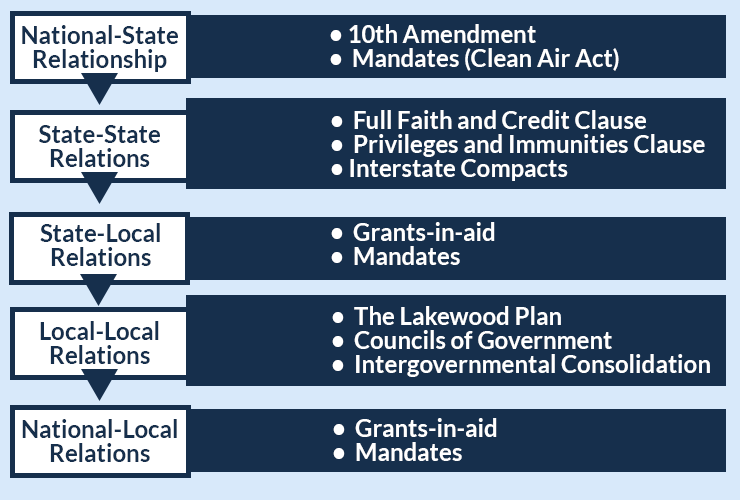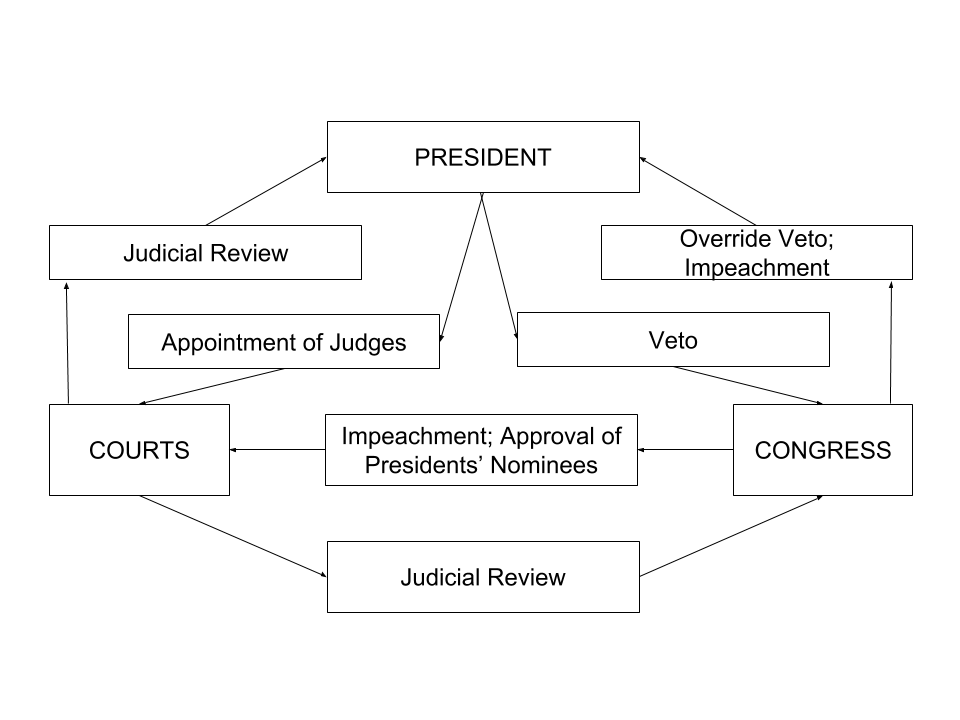Main Content
Lesson 2 : The Policy Making System, History and Structure of Policy Making in the United States
Key Elements in the Constitutional Order
Two aspects of the constitutional order are especially relevant to the policymaking process: federalism and the separation of powers (accompanied by checks and balances).
Federalism
Federalism refers to the division of powers across levels of government (usually focusing on the interactions between the federal government and the states). The Constitution itself notes one key component of federalism—the supremacy of national laws and the Constitution over state laws and constitutions. Over time, federalism has evolved considerably. Interested students might read Chapter 3 of the Deil Wright's Understanding Intergovernmental Relations (1988) to get a sense of the change over time.
Intergovernmental relations (IGR) is a more complete view of the interactions among levels of government.

Figure 2.3 illustrates the ways in which levels of government can interact with one another. Please check different types of relationships for details via the following tabs.
National–State Relations
The national government and the state governments interact in a number of ways. The 10th Amendment lays out the states' powers (known as "reserved" powers) and the people's powers, which include powers neither granted to the federal government nor prohibited to the state governments.
Another mechanism of interaction is the mandate, in which the federal government tells a state government what it has to do (based on the supremacy clause of the Constitution). For instance, the national government can pass a law requiring states to make sure that all eligible voters can vote (this was done with the 1965 Voting Rights Act). In many southern states, obstacles were erected to make it more difficult for African-Americans to vote. The Voting Rights Act essentially told those states to cease that practice.
Other interactions come from national grants, funds made available to states to carry out projects deemed appropriate by the national government.
State–State Relations
The IGR system also includes state-level interactions. The Constitution specifies full faith and credit, as well as privileges and immunities, as discussed earlier. States can also form compacts (agreements) with one another to address mutually agreed-upon issues, as with the Connecticut River Valley Flood Control Commission (formed by Connecticut, Massachusetts, New Hampshire, and Vermont).
State–Local Relations
States have relationships with their local governments—those of counties, cities, or villages. States have grant programs that make funding available to local governments to serve state needs. For example, the Oregon Parks and Recreation Department makes available over $4 million annually to communities throughout the state for outdoor recreation projects. The funding for the grants comes from state lottery money (OREGON.GOV, 2015). And, of course, states may enact mandates for lower-level governmental entities. One example comes from Minnesota: If a county participates in the community corrections act, the county attorney must establish a pretrial diversion program for adult offenders designed to achieve five goals specified in the statute (State of Minnesota, 2015).
Local–Local Relations
Local governments can develop relationships to advance their interests. For instance, the Lakewood Plan (named after a community in California) features cities contracting with the county government to provide various services, from law enforcement to planning activities.
Another local–local interaction can be seen in councils of government, in which a number of municipalities join an organization designed to coordinate actions and work collaboratively on issues of common interest.
A dramatic form of local–local relations is intergovernmental consolidation. We see this occurring when Davidson County, Tennessee and its largest city, Nashville, combined into one governmental entity, currently known as the "Metropolitan Government of Nashville and Davidson County" or "Metro Nashville."
National–Local Relations
Finally, the national government interacts with local governments in a number of ways, including making grants available for them or imposing mandates on them.
Another critical aspect of the American constitutional order is the separation of powers and checks and balances. Take a look at Figure 2.4, which illustrates this.
Separation of Powers/Checks and Balances
Figure 2.4 is a flowchart that indicates checks and balances regarding the separation of powers among the executive, judicial and legislative branches.
Separation of powers is fairly straightforward:
- Congress has the power to enact laws (legislative power),
- the president has the power to implement and enforce laws (executive power), and
- the courts have the power to interpret laws and apply the law to specific cases (judicial power).
Each of the three branches of government has the ability to "check" the others. The courts can check the executive and legislative branches by declaring their actions or decisions unconstitutional (known as judicial review). The president can check Congress by vetoing legislation; Congress can check the president by overriding the veto. The president checks the court by nominating judges when there is a vacancy or when a new court is established. Congress has a check over the courts: it can impeach and remove judges from office and approves the president's nominees. Of course, in this manner, Congress can also check the president if it objects to his nomination(s).
Messiness in Policymaking
The constitutional order affects policymaking; another graphic should make this clear. If we combine federalism and separation of power, we get Table 2.2 below.
What does the table tell us? Above all, the policymaking process is fragmented (note the discussion on this in the textbook). Power is divided by level of government and by the different branches of government. The end result is that it is often difficult to make a policy that is likely to have the desired impact. The president, Congress, governors and their state legislators, and the executive and legislative bodies at the local level normally need to agree on actions at each level. Often there are standoffs between the executive and legislative branches, rendering decision-making a challenge. Add to this the political parties, which may be at odds when there is a divided government, with one party controlling at least one component of government and the other party at least one, too.
| Level of government/separation of power | Executive | Legislative | Judicial |
|---|---|---|---|
| National | R D | R D | R D |
| State | R D | R D | R D |
| Local | R D | R D | R D |
References
OREGON.GOV (2015). Oregan Parks and Recreation Department: Grant Programs. Retrieved from http://www.oregon.gov/oprd/grants/pages/local.aspx#Local_Government_Grant_Progra
State of Minnesota (2015). Minnesota Statutes 2015. Retrieved from https://www.revisor.mn.gov/statutes/?id=401.065&format=pdf
Heineman, R. A., Peterson, S. A, & Rasmussen, T. H. (1995). American Government. 2nd edition New York, NY: : McGraw-Hill.
Peterson, S. A., & Rasmussen, T. H. (1994). State and Local Politics. New York, NY: McGraw-Hill.
